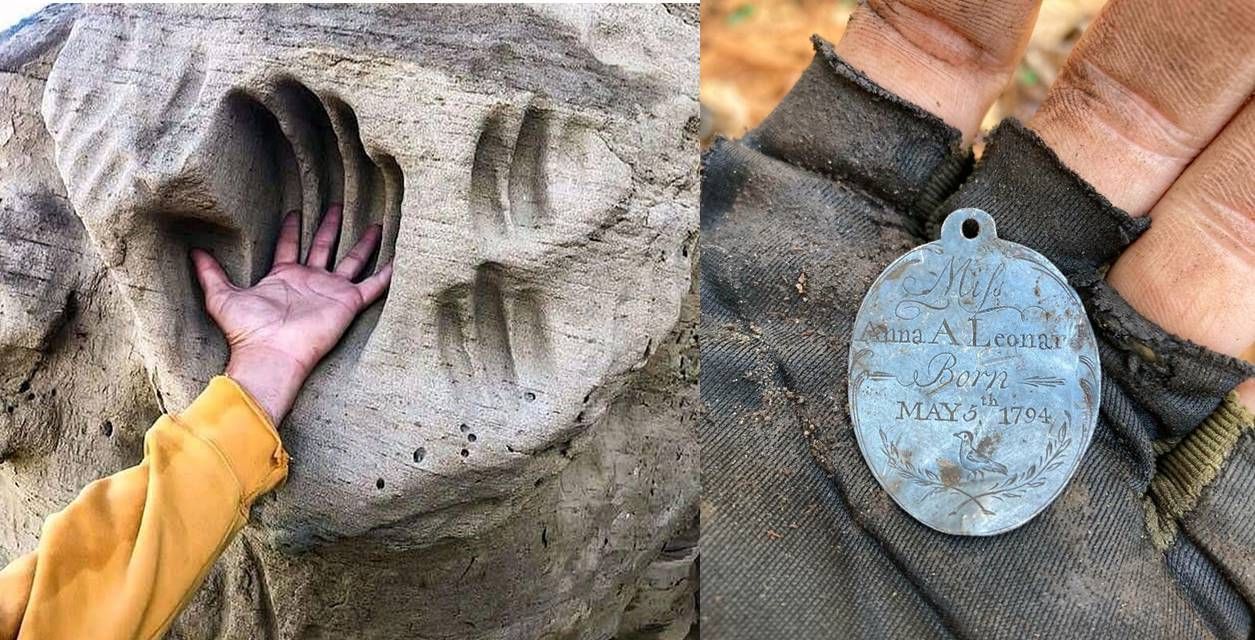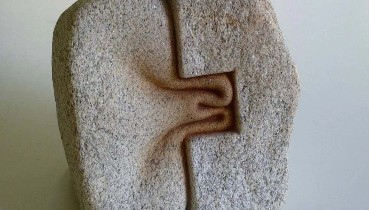

Interesting Archaeological Findings That Survived The Ravages Of Time
Archaeology is a fascinating study as it explores how our ancestors have evolved over thousands of years to this very moment in time. Indeed, these historical artefacts give us a unique glimpse back in time and the little steps we took to get to our current situation give us a new appreciation for the steps we need to take in the future too.
If looking back on the passage of time and its discoveries appeals to you, scroll below for a collection of amazing museum-worthy finds that are downright fascinating in the perspective it provides.
More info: X | Instagram
#1 Amid A Drought, The Dinosaur Valley State Park Has Discovered Dinosaur Footprints That Have Historically Been Covered By Water And Sediment. They Date Back More Than 113 Million Years

Image source: Dinosaur Valley State Park – Friends
#2 A Mammoth Tusk Just Found In The Arctic

Image source: taykaybo
#3 A Roman Bead That Was Recently Found By The Vindolanda Trust At The Ruins Of Vindolanda Fort In Northern England

Image source: VindolandaTrust
#4 2000-Year-Old Green Serpentine Stone Mask Found At The Base Of Pyramid Of The Sun, Teotihuacán, Mexico

Image source: Instituto Nacional de Antropología e Historia
#5 This Is A 2000-Year-Old Dog Paw Print

Image source: tthirzaa
This is an approximately 2000-year-old Roman roof tile with a dog paw print on it. After being formed it was left to dry on the ground and a dog stepped on it while the material was still wet.
Found this in the Roman bathhouse museum in Heerlen, The Netherlands, while on holiday.
It’s a museum built around the excavation site of the oldest building on Dutch soil. A bathhouse was used by the wealthy to enjoy hot and cold baths, pools, saunas, steam rooms, and massages. This particular one was discovered about 150 years ago in the Southern part of The Netherlands. The south part (up until the river the Rhine) was occupied by the Romans during the time of the Roman Empire.
#6 Found This Fossil Today

Image source: Im-A-Scared-Child
#7 Back In 2014, The Secrets Of The Ice Program Found An Exceptional Pre-Viking Ski, 1300 Years Old, At The Digervarden Ice Patch In Norway

Image source: secretsoftheice, secretsoftheice.com
The ski was complete, including the binding – one of only two skis from prehistory in this condition. Ever since, we have monitored the ice patch, hoping and praying for the second ski of the pair to melt out. Now it has happened! The new ski is even better preserved than the first one! It is an unbelievable find.
#8 A Viking Sword Found At A High Altitude

Image source: Secrets Of The Ice
#9 Letter By A Woman To Her Deceased Husband, Discovered In The Man’s Grave Along With A Lock Of Her Hair. Korea, 1586

Image source: Andong National Univerisity Museum
The letter says: “You used to always say to me, ‘Let’s live together until our hair turns white and die on the same day.’ So how could you go ahead and leave me behind?”
#10 My Friend Just Found This Little Statue While Digging In His Own Garden

Image source: lodeluxMeaLux
The archeologists from the museum told him that it is probably from a grave dating back to 3-4000 years ago. It has been found in Castell’ Arquato, PC, Italy. He proceeded to give it to the Museum Of Parma.
#11 I Actually Found A Medieval Silver Treasure Yesterday. 1 Penning From About 1165. It’s A Lifetime Find. I Contacted My Archaeologist About It

Image source: reddit.com
#12 Medieval Gold Ring I Just Found

Image source: tombalol
I am not 100% sure of the age but believe it to be the 15th century, although it could be a lot later.
#13 I Found This Elizabeth I Penny While Metal Detecting Yesterday. It’s Only 14 Mm In Diameter

Image source: poshjosh1999
#14 The Capstone Of The Pyramid Of Amenemhat III, 1860 BC – 1814 BC

Image source: Chirphy
#15 Archaeologists In Northern Spain Accidentally Uncovered A 2,000-Year-Old Roman City That Had Been Completely Lost To History

Image source: Gobierno de Aragón
The researchers were shocked by their discovery of this “monumental” city with no known name and no mention in any historical record.
#16 Archaeologists Have Made A Rare Find In Nördlingen, Bavaria: During Excavations, Experts Discovered A Bronze Sword More Than 3,000 Years Old

Image source: arkeofili, Dr. Woidich / Sergiu Tifui
This is so well preserved “that it almost still shines”.
It is estimated to belong to the late 14th century BC and thus to the Middle Bronze Age.
The sword now discovered came from a grave provided with rich bronze objects. A man, a woman, and a youth were buried in it. It is still unclear what relationship the people may have had with one another.
#17 In 2000, Archaeologists Discovered A Long Lost Egyptian City Heracleion That Was Abandoned And Sunk Into The Sea For More Than 1200 Years

Image source: Christoph Gerigk
Among the underwater ruins were 64 ships, 700 anchors, a treasure trove of gold coins, statues standing at 16 feet, and most notably the remains of a massive temple to the god Amun-Gereb, and a tiny sarcophagus for an animal.
These magnificent statues were recovered from the depths of Aboukir Bay by the European Institute for Underwater Archaeology, under the direction of Franck Goddio. With the support of the Hilti Foundation, these statues have found their rightful place.
#18 Some Of The Numerous Handprints That Were Carved Into The Soft Sandstone Surface Of The White Mountain, In Wyoming, By The Ancestral Eastern Shoshone, 1000-1800 CE

#19 We Found A Sword While Making A Road Next To Our Property

Image source: KizziQ
It was found in Slovenia where used to be the Habsburg monarchy / Illyrian provinces people have been saying there were stables on the place where the sword was found.
#20 17th Century Boots, Certamen Equestre

Image source: Göran Schmidt
#21 This Is Why We Love Glacial Archaeology! See How Happy We Are When We Get To Hold An Arrow, Which Has Been Lost In The Ice For 1500 Years

Image source: secretsoftheice
The arrow was discovered between the stones in the scree. It was found near the lower edge of the ice, but was probably lost in the snow further up the slope. When it later melted out, it was transported downslope by meltwater and ended up on the ground where we found it.
The arrow has probably been exposed a few times after it was lost in the snow, as the fletching is gone and the sinew and tar are not perfectly preserved. Still, the preservation is pretty awesome.
#22 Mosaics Of A Roman Villa Were Found Under A Vineyard In Negrar, Italy

Image source: Comune di Negrar di Valpolicella
#23 A Gold Bar With Mint Marks, Recovered From The Spanish Treasure Ship “Atocha” Which Sank In 1622

Image source: itsbissell
#24 A Centuries-Old Wooden Statue Was Recently Discovered By A Group Of Dutch Shrimp Fishermen Off The Coast Of Texel

Image source: VictorAyal82
A municipal archaeologist for that region believes that the statue came from a warship, possibly during the 80 Years’ War, which stretched from the mid-1500s to mid-1600s.
#25 A 2000-Year-Old Glass Mosaic, Founded In The City Of Zeugma, Turkey

Image source: zeugma.packhum.org
#26 This Is A 3200-Year-Old Attendance Sheet Found In Deir El-Medina, Egypt. Reasons For Worker Absence Include “Embalming Brother”, “Brewing Beer” And “Bitten By Scorpion”

Image source: Alison Fisk
#27 A Ceramic Jar Filled With Thousands Of Bronze Coins Was Unearthed At The Site Of A 15th-Century Samurai’s Residence Just North Of Tokyo, Japan

Image source: Saitama Cultural Deposits Research Corporation
#28 Viking Ice Skates, Made From Leather And Horse-Bone, Found In York

Image source: JORVIK Viking Centre
We discovered 42 pairs of Viking-age ice skates in York – the majority were made from horse leg bones although cattle leg bones were also used.
#29 First-Time Metal Detecting. Found An Over 100-Year-Old Time Capsule

Image source: Gtclem0
#30 This Archaeological Wall Of Engravings I Found While Hiking

Image source: MohammadJacob
#31 An Ancient Clay Tablet Found In Uruk (Warka), Southern Iraq

Image source: The-Arabian-Guy
Inscribed with a Cuneiform script and 3 geometric circles containing astronomical calculations, dated to the ancient Babylonian period (2004-1595 BC). Iraqi Museum, Babylonian Gallery.
#32 Ukrainian Soldiers Dug Trenches And Discovered Ancient Amphoras Dated To Around 4-5 Centuries BC. Artifacts Were Transferred To The Odessa Archaeological Museum

Image source: 126brigadatro
#33 This Silver Pendant I Found While Metal Detecting Is Dated 227 Years Ago Today

Image source: Silver_Winged
#34 A 1,700-Year-Old Roman-Era “Good Shepard” Gold Ring Bearing An Engraving Of A Boy Holding A Sheep On His Shoulders, An Image Used By Early Christians To Symbolise Jesus

Image source: Israel Antiquities Authority
#35 My Buddy Threw His Detector Down And Started This Wild And Crazy Dance. I Asked Him What He Found, But He Couldn’t Speak. He Had To Point To It

Image source: Buck_Thorn
#36 Executioner’s Sword With An Inscription That Reads “When I Raise This Sword, So I Wish That This Poor Sinner Will Receive Eternal Life”. Germany, Late 17th Century

Image source: Gift of Mr. and Mrs. John L. Severance
#37 Incredible Rare Roman Statues Found In HS2 Rail Construction Dig

Image source: High Speed Two Limited, High Speed Two Limited
#38 A Gallic Bronze Helmet In The Shape Of A Swan, Found By Archeologists In Tintignac, France, In 2004 (4th-2nd Century BCE)

Image source: reddit.com
#39 I Found This Arrowhead While Digging A Hole In My Backyard

Image source: Jonahw8
#40 Found An Arrowhead In A Dried-Up Stream

Image source: awkwardlytallguy
Many people recommended that I contact an archeologist, so I did! Here’s what he had to say about my find. The point is a variant of a Waubesa Contracting Stem. The point type was typically made during the Woodland time period (500 BC – 1700 AD).
Recommended Videos
 The red-crowned crane (Grus japonensis)333 views
The red-crowned crane (Grus japonensis)333 views Meet Barry, A Gloster Canary That Has A Fabulous Bowl Feathercut113 views
Meet Barry, A Gloster Canary That Has A Fabulous Bowl Feathercut113 views-
Advertisements
 China's 40 most beautiful landscapes.1469 views
China's 40 most beautiful landscapes.1469 views Photographer Captures Amusing Photos Of Beautiful Mantises70 views
Photographer Captures Amusing Photos Of Beautiful Mantises70 views Could Ancient Peruvians Really Know How To Melt Stone Blocks..193 views
Could Ancient Peruvians Really Know How To Melt Stone Blocks..193 views 30 Times People Just Had To Shame Ugly, Horrible Or Plain Hilarious Dresses1623 views
30 Times People Just Had To Shame Ugly, Horrible Or Plain Hilarious Dresses1623 views The Healing Powers of Guava Leaves: Nature’s Remedy for Wellness226 views
The Healing Powers of Guava Leaves: Nature’s Remedy for Wellness226 views Orchid mantis (Hymenopus coronatus)567 views
Orchid mantis (Hymenopus coronatus)567 views
You may also like
 Photographer captures rare pictures of exotic birds
Photographer captures rare pictures of exotic birds  Golden Plover chicks are covered in downy feathers that mimic actual moss to blend in with their surroundings.
Golden Plover chicks are covered in downy feathers that mimic actual moss to blend in with their surroundings.  40 Real-Life Angry Birds
40 Real-Life Angry Birds  Wilson's bird-of-paradise (Cicinnurus respublica) is a species of passerine bird of the family Paradisaeidae.
Wilson's bird-of-paradise (Cicinnurus respublica) is a species of passerine bird of the family Paradisaeidae.